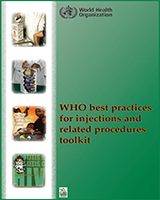All rights reserved. Publications of the World Health Organization can be obtained from WHO Press, World Health Organization, 20 Avenue Appia, 1211 Geneva 27, Switzerland (tel.: +41 22 791 3264; fax: +41 22 791 4857; e-mail: tni.ohw@sredrokoob). Requests for permission to reproduce or translate WHO publications – whether for sale or for noncommercial distribution – should be addressed to WHO Press, at the above address (fax: +41 22 791 4806; e-mail: tni.ohw@snoissimrep).
NCBI Bookshelf. A service of the National Library of Medicine, National Institutes of Health.
Overview
The new WHO guidelines provide recommended steps for safe phlebotomy and reiterate accepted principles for drawing, collecting blood and transporting blood to laboratories/blood banks.
The main areas covered by the toolkit are:
- bloodborne pathogens transmitted through unsafe injection practices;
- relevant elements of standard precautions and associated barrier protection;
- best injection and related infection prevention and control practices;
- occupational risk factors and their management.
Contents
- Preface
- Acknowledgements
- Acronyms
- 1. Background
- 2. Best practices for injection
- 3. Best practice in phlebotomy and blood collection
- 4. Occupational risks and management of bloodborne pathogens
- 4.1 Basic occupational health care
- 4.2 Prevention of needle-stick injuries and other blood exposures using a hierarchy of controls
- 4.3 Overview of management of exposure to blood
- 4.4 Evaluation and management of exposure to HBV
- 4.5 Evaluation and management of exposure to HCV
- 4.6 Management of exposure to HIV
- References
- Annex A Indications for glove use in health care
- Annex B Disassembly of needle from syringe or other devices
- Glossary
The designations employed and the presentation of the material in this publication do not imply the expression of any opinion whatsoever on the part of the World Health Organization concerning the legal status of any country, territory, city or area or of its authorities, or concerning the delimitation of its frontiers or boundaries. Dotted lines on maps represent approximate border lines for which there may not yet be full agreement.
The mention of specific companies or of certain manufacturers' products does not imply that they are endorsed or recommended by the World Health Organization in preference to others of a similar nature that are not mentioned. Errors and omissions excepted, the names of proprietary products are distinguished by initial capital letters.
All reasonable precautions have been taken by the World Health Organization to verify the information contained in this publication. However, the published material is being distributed without warranty of any kind, either expressed or implied. The responsibility for the interpretation and use of the material lies with the reader. In no event shall the World Health Organization be liable for damages arising from its use.
- NLM CatalogRelated NLM Catalog Entries
- Review WHO Guidelines on Drawing Blood: Best Practices in Phlebotomy[ 2010]Review WHO Guidelines on Drawing Blood: Best Practices in Phlebotomy. 2010
- OSHA's bloodborne pathogens standard: analysis and recommendations.[Health Devices. 1993]OSHA's bloodborne pathogens standard: analysis and recommendations.. Health Devices. 1993 Feb; 22(2):35-92.
- Review Unsafe injections in the developing world and transmission of bloodborne pathogens: a review.[Bull World Health Organ. 1999]Review Unsafe injections in the developing world and transmission of bloodborne pathogens: a review.Simonsen L, Kane A, Lloyd J, Zaffran M, Kane M. Bull World Health Organ. 1999; 77(10):789-800.
- Review Assessment of infection control practices for interventional techniques: a best evidence synthesis of safe injection practices and use of single-dose medication vials.[Pain Physician. 2012]Review Assessment of infection control practices for interventional techniques: a best evidence synthesis of safe injection practices and use of single-dose medication vials.Manchikanti L, Falco FJ, Benyamin RM, Caraway DL, Helm Ii S, Wargo BW, Hansen H, Parr AT, Singh V, Hirsch JA. Pain Physician. 2012 Sep-Oct; 15(5):E573-614.
- Review Bloodborne pathogens. What you need to know--Part I.[AAOHN J. 2003]Review Bloodborne pathogens. What you need to know--Part I.Twitchell KT. AAOHN J. 2003 Jan; 51(1):38-45; quiz 46-7.
- WHO Best Practices for Injections and Related Procedures ToolkitWHO Best Practices for Injections and Related Procedures Toolkit
- tmem183a transmembrane protein 183A [Danio rerio]tmem183a transmembrane protein 183A [Danio rerio]Gene ID:541482Gene
Your browsing activity is empty.
Activity recording is turned off.
See more...
